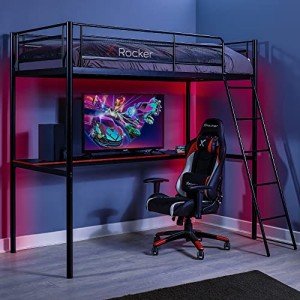Here's An Interesting Fact About Kids Bunk Bed. Kids Bunk Bed
The Ultimate Guide to Kids Bunk Beds: Maximizing Space and Fun
With the rise of vertical living and smaller spaces, the popularity of bunk beds has actually skyrocketed among households. Bunk beds not only offer a practical sleeping solution, specifically in shared rooms, however they also bring an aspect of fun into a child's life. This extensive guide looks into the features, benefits, and considerations of kids' bunk beds, making it simpler for parents to select the right bed for their kids.
Functions of Kids Bunk Beds
Bunk beds are flexible pieces of furniture that serve more than a single purpose. Here are some crucial functions to consider:
Feature
Description
Product
Bunk beds can be built from wood, metal, or a mix of both, using differing levels of durability and style alternatives.
Safety Features
Many bunk beds come geared up with guardrails, protected ladders, and topped assistances for security, specifically important for young kids.
Style Variety
Options range from timeless designs to modern-day designs, ensuring a match for any room decoration.
Space-Efficiency
Bunk beds make use of vertical space, making them ideal for smaller sized rooms.
Convertible Options
Some designs can be transformed into two separate beds, providing flexibility as children grow.
Storage Solutions
Some bunk beds include integrated storage drawers or shelves, assisting to keep the space arranged.
Benefits of Kids Bunk Beds
Investing in a bunk bed includes several benefits:
- Space Saving: Bunk beds optimize flooring space, permitting more play location or storage services.
- Fun Factor: With a bunk bed, kids belong that cultivates imagination and companionship during slumber parties or playdates.
- Economical: Instead of purchasing two different beds, a bunk bed can accommodate 2 kids at the same time, saving money in the long run.
- Versatility: Many bunk beds can be taken apart or transformed into twin beds, making them a long-term investment as children's requirements change.
- Social Interaction: Bunk beds encourage family bonding and friendships, providing a welcoming space for kids to share stories and laughter.
Considerations When Choosing a Kids Bunk Bed
When selecting the ideal bunk bed for a child, moms and dads should take into account numerous elements:
- Safety Standards: Ensure that the bunk bed adhere to security regulations and includes important safety functions.
- Age Appropriateness: Different models cater to different age. For example, conventional bunk beds might not be suitable for younger children.
- Space Dimensions: Measure the bedroom to guarantee the bunk bed fits appropriately, permitting for space to move around easily.
- Weight Capacity: Consider the weight load of each bed and ensure it accommodates the kid's weight easily.
- Design Preferences: Letting kids take part in the choice process can help them feel more excited about their new bed.
Kinds Of Kids Bunk Beds
Bunk beds come in different styles and configurations to fit various requirements:
Type
Description
Standard Bunk Bed
A traditional style with one bed stacked on top of another, typically utilizing a ladder to access the leading bunk.
L-Shaped Bunk Bed
Functions 2 bunk beds connected in an L-shape, often more roomy and ideal for kids sharing a room but requiring a bit more space.
Triple Bunk Bed
Comprises three stacked beds, ideal for optimizing sleeping arrangements in very restricted spaces.
Loft Bed
A raised bed with space beneath that can act as a play location, study corner, or additional storage.
Futon Bunk Bed
Integrates a bunk bed on the top with a futon or couch beneath, making it great for sleepovers and taking full advantage of room use.
Convertible Bunk Bed
Can be separated into 2 individual beds, providing versatility as children's needs alter.
Taking Care Of Kids Bunk Beds
Preserving bunk beds is essential for ensuring durability and safety. Here are some simple care practices:
- Regular Inspections: Check the bed frequently for loose screws and tightened up bolts to ensure stability.
- Cleanliness: Keep bedding clean and fresh, rotating bed mattress for even use.
- Guardrails: Ensure guardrails are safe and in location, specifically if children tend to move around a lot in their sleep.
- Air Circulation: Ensure the bed has sufficient airflow, avoiding moisture buildup that can result in mold or mildew.
Frequently Asked Questions About Kids Bunk Beds
Q1: At what age can a kid safely utilize a bunk bed?
A1: Generally, children aged 6 and older are thought about safe to utilize the upper bunk due to the height and stability factors involved.
Q2: Can I place a bunk bed near a window?
A2: It is advisable to avoid putting a bunk bed near windows to reduce the risk of falling or injuries.
Q3: Are bunk beds safe for younger children?
A3: While some modern-day bunk beds feature safety functions accommodating more youthful kids, it is usually suggested to wait until they are older, typically over 6 years.
Q4: What is the normal weight limitation for leading bunks?
A4: Weight limitations differ by design however usually vary from 150 to 250 pounds. Always refer to the manufacturer's specifications.
Q5: How typically should I inspect the bunk bed's safety functions?
A5: It is advisable to conduct a safety check every few months or whenever you observe any indications of wear.
Kids' bunk beds function as a strategic service for families aiming to take full advantage of space while supplying an enjoyable and appealing sleeping environment for their children. With a range of choices offered— from basic styles to loft beds— moms and dads have the liberty to select something that fulfills their family's specific requirements. By considering click through the following document as security, space suitability, and their kids's choices, parents can make an educated option, ensuring that each child is thrilled about bedtime while taking advantage of a well-organized space.
